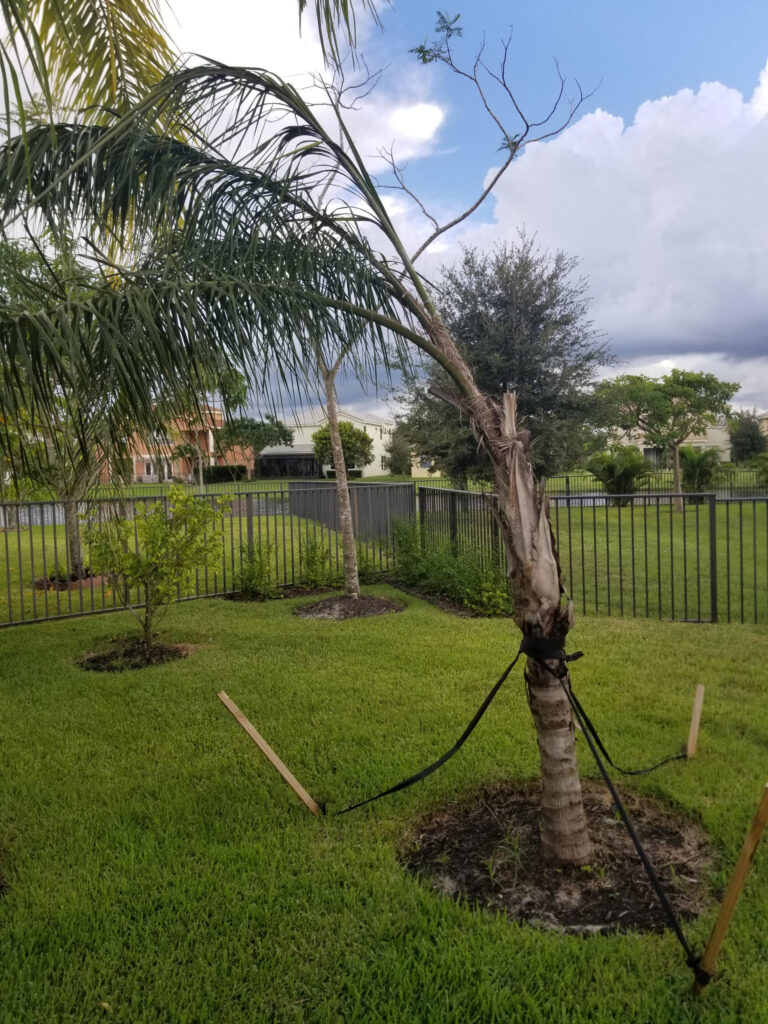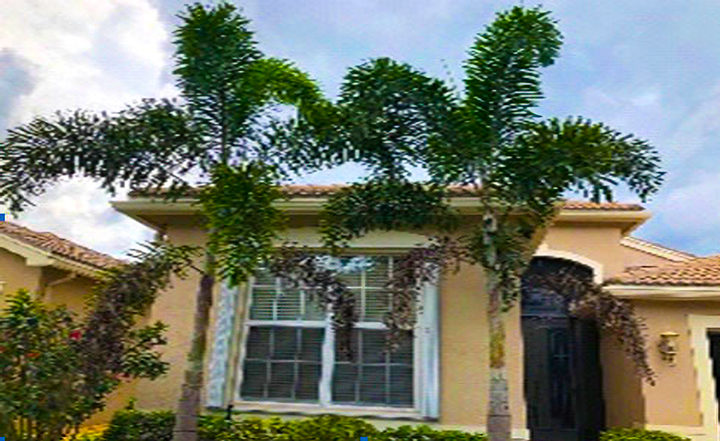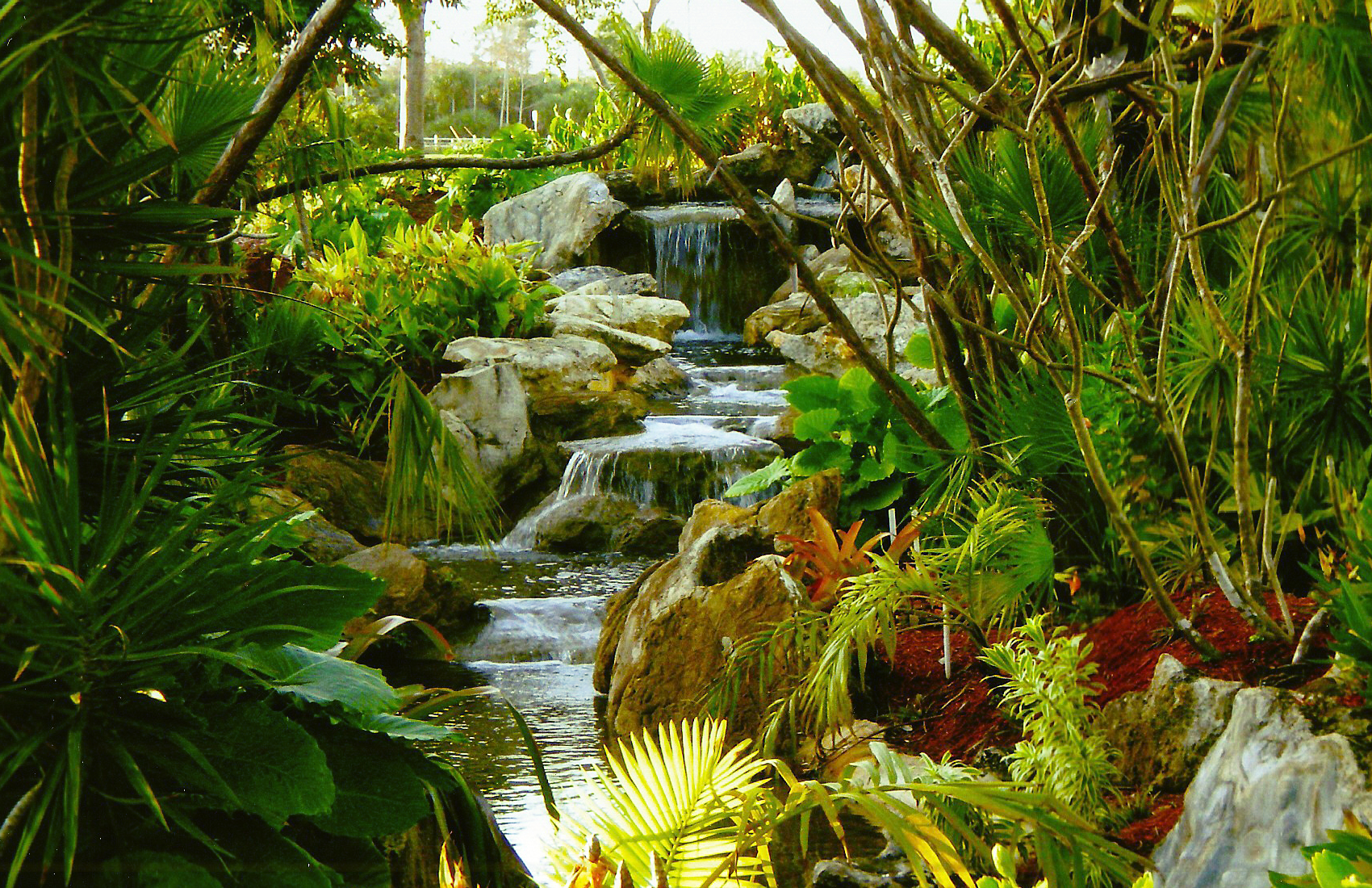Question: I’ve been watering as instructed and we’ve had a few days with some solid rain. As you can see, a couple of fronds (on recently installed palm trees – within weeks) on the bottom of each tree are dead. Is there something else I should be doing?
Answer : Thank you for the photo, very helpful. The quick & simple answer is this is normal and there is nothing concerning about the palm dropping it’s lower frons in the weeks following installation.
We get many questions after a landscape is installed and we encourage them, it helps us to keep tabs on how the landscape is doing and the emailed photos helps us to know if we need to schedule a quick trip for an adjustment, if a situation is normal, or if we might need to make a replacement. If we are concerned about an installation after you let us know, we will often ask for updates with a tree or planting if we think it’s going through an unusual shock we are concerned.
So, if you aren’t sure, always better that you, as our customer (and our customer’s only) send in a photo by email to us , than not, so we can know.

The photo above doesn’t raise any alarm bells for us.
The photo here to the of this young Coconut palm is of concern.
What is concerning about the Coconut palm here is that the center stalk is wilting. That is the sign that the heart of the tree of the palm is in extreme stress. There are things we can do to help and sometimes, the tree will go. Usually a vitamin boost, micro nutrients, organics, checking soil and watering can help, but with a wilting center stalk, this is not a good sign of health.
Again, comparing with the same initial photo the Coconut palm photo repeated again below is not experiencing wilting of the center new growth stalk of the tree, just browning of the lower palm frons.

Question: What is a normal amount of frons (palm branches) that can turn brown after an installation?
The browning of the lower palm frons (the branches of a palm tree) is a Normal occurrence with most palms, and happens with any species after installation.
Here are 2 photos of young Christmas palms at about 9 foot tall, just installed. First photo shows the 2 Christmas when they were first installed.

Notice that there is full green frons (branches) on both palm trees in this photo. Looks good.
The next photo here shows the same Christmas palms 2 weeks later and there is browning of the lower from branches.

Again, with the Coconut palm example above, the lower branches, or called frons have turned brown and should be trimmed off.
Again, this is a normal occurrence for the lower branches of any palm tree after installation. Some hardly will drop at all sometimes after installation, some may drop more than average and there are different factors that can cause this.
2 Related Questions:
So what causes these lower branches on palm trees to brown out and drop after installation?
And why do some have new palm trees have more browning of their lower frons, branches, than others?

The photo below shows a healthy pair of Coconut Palms and Bismarkia (Greyish green fronted palm in center) 2 years after installation. These palms were not very large upon installation, Bismarkia was at about 9′ height and at approximately 14′ in photo here and Coconuts were at about 10′ – 11′ upon installation and are at approximately 17′ at top height of the frons here.

The severity of palm fron browning after installation can change with different palms, the size of them & often you will see a few branches turn brown, 1 to 3. Some will have more browning. The fewer the better for all of us of course, but unless the browning is close to 30 % in some cases, there is usually not a case for concern.
What causes the browning is that when the trees are moved from a field, especially if they are dug out for the larger tree sizes, the roots are cut.
The root systems are the primary way that a trees receives nutrition.
When the roots are cut, the food supply to the tree is disturbed and then the stress of transport and installation. It is very often, without comparison, the most stressful time in a trees life when it is installed.
The roots need to become re-established and as the older established roots that were cut when the palm was removed, it immediately goes into a state of self preservation in a sense. This involves dropping its older palm frons first to protect the newer growth.
The older frons on a palm tree are the lowest branches.
As is the natural process for any palm that has been established in a landscape for any period of time, from years to decades, the lower branches will die off as it makes way for the newer branches which come out of the top, the center of the palm tree.
By dropping the lower branches, less food is needed for the palm to supply the entire palm tree as it was before it was cut from the nursery field.
The less nutrition that is being supplied is going also to feed fewer palm frons to survive the shock of being cut and re-installed.
Immediately, the palm tree will work to re-grow its roots. This is also a reason why a new palm, and actually an entire new landscape, requires more water upon the time of installation than any other time. From the first days after installation through the first few weeks are very important. The larger the new palm in the landscape, the more watering should be supplied. We have guidelines to follow in other articles here. Soil conditions can also have an effect on the amount of watering required. Some sandy, well draining soils may require more watering than normal and those with dense, flooding or poor draining properties may require less water.
From the first few weeks, through the first few months, it is very important to pay attention to how the palm is doing. As noted, the browning of the bottom branches is a natural process of the palm tree going through an acclimation period, re-establishing roots in its new home.
What is of concern and we hope any customer of ours would let us know by a photo and an email, is any wilting of the palm tree after installation. Not the wilting of the lower branches, but the center stalk which represents the new growth of a palm tree. As in the 2 photos below:

This Queen palm was installed in a poorly draining property but still the tree should be ok if planted above grade, enough to compensate for a property that holds too much water as this one did.
This palm tree did die. When the tree was removed from the hole, water was visible in the hole. This is also what led to the difficulty for the roots to become established as when there is too much water in the ground, to this extreme level, the roots will not need to grow outward and grab into the soil.
The new tree that was replaced was planted at a higher elevation above the grade level of the property and years later is doing well. Primarily because of compensating for that extreme case of a consistently damp property during some wet summers and poor drainage.
To note, we could have corrected the problem with the drainage, but it can be an expense some don’t invest in.
Why some palms may drop more frons than others, even the same variety of palm, from the same field, planted at the same time :
This can lead to how severely the roots were cut or damaged during the removal from a field during the process of installation. Some palms might have established deeper roots and those may go into a greater shock. Those trees with more shallow roots, will tend to go through less.
Even with a shallow rooted palm, from a quality grower, it is normal to expect browning.
To note even palms that were installed from containers will tend to have browning of the lower palm frons in the weeks and months after installation. Less than the larger field grown trees that were cut out from the ground, but the container trees will typically drop some frons as well, as the above examples of smaller palms.
This again is simply as a palm tree is disturbed from where it has been growing, shaken during the loading, transport and unloading to a degree & then removed from the container and installed into its new home.
Again, the most stressful time in the life of the palm until that point most often.
We would rather encourage our customers to send us a photo if they are unsure. We hope they would read this to become better educated and to better know what to expect in regards to the browning after installation. However, we would rather be on the safe side and have our customers let us know by photo and email and we then can respond. We save the photos in question into a file for them and in those cases where a tree is in a state of concerned stress, we can take any preventative measures possible and because we have been notified, stand behind the warranty.
The reason, during the installation into the Watering notes directly after installation and through the longer term: very important.
The watering notes that are both on our website and emailed to customer’s after a project stress the importance of watering daily first. The first few weeks, daily irrigation watering for 45 minutes to 1 hour is normal, and can have increased recommendations based on the size of a tree and/ or the soil conditions of a property.
After the first few weeks, we suggest starting to skip a day, keeping the time of watering the same until past the 3 month mark. Once past that mark, a landscape is usually in the clear. If there may be a problem with a landscape it will usually show up in those first 3 months.
After that point, we recommend a Xeriscape Watering strategy to help the roots grow deeper and stronger into the ground and we have articles on our site of this as well.
We also have an article on “How to help a struggling palm tree” as well in our “Customer’s Corner” for those dealing with possibly years after the warranty has passed if they are having a problem. Also for general information for any dealing with the issue.
If there are special notes we have about the soil of a property or a certain palm tree, larger one’s usually will require a closer eye as they become established as the larger the tree, the greater the watering requirements right after installation.

The trees in this photo above are not considered by us in that ‘larger category’ more of a smaller size as they are approximately 12′ to 14′, but still important to keep an eye on during the first few months.
If the amount of palm frons that browns increases let us know. Otherwise, this is to be expected after a palm tree is Installed. After a few months, the roots will begin to become more established and will ultimately the roots will be providing more and more nutrition and the result will be a growing tree.
Make sure to fertilize at least 2 to 3 times in the next year. We recommend 13 – 3 – 13 for palms, which can be purchased at Home Depot. Follow the instructions on the bag, approximately 40 lb bag for about $45. If you need help with this, let us know.
Another thing to keep an eye out for is to make sure it stays a good healthy green and the Fertilizing will help with this.





